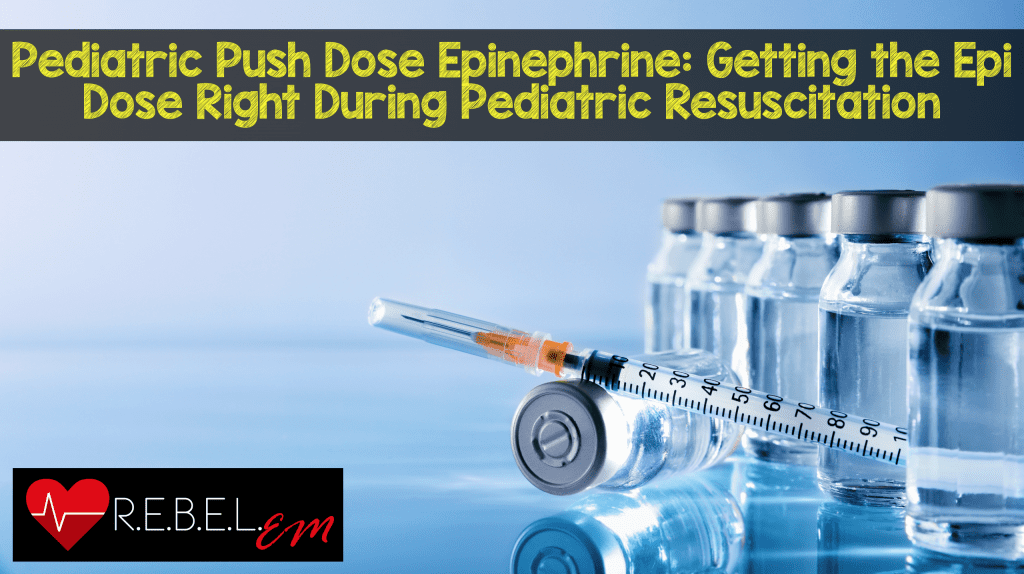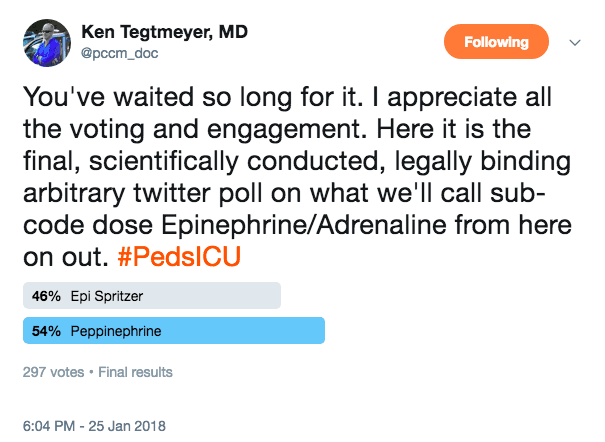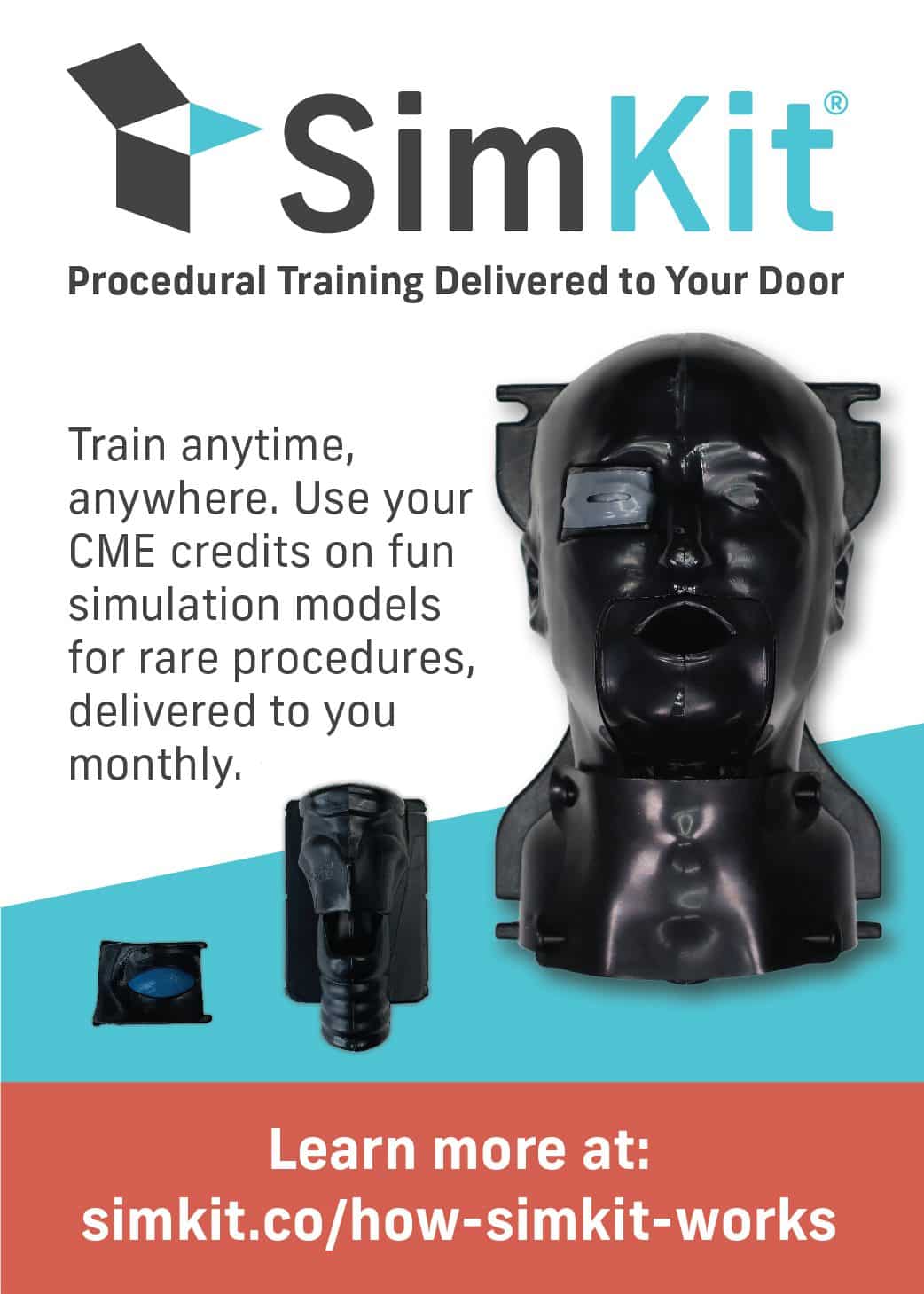Warning: Limited Published Evidence on this Topic
 You have just intubated a 4 year old with sepsis from a bad pneumonia. Post intubation BP is 70 systolic, while waiting for the epinephrine (adrenaline) infusion to come up from pharmacy you watch the BP decline into the 60 systolic range and start to use fluids to resuscitate. You are an accomplished adult resuscitationist, and are comfortable mixing, and pushing push dose epi in your adult patients.
You have just intubated a 4 year old with sepsis from a bad pneumonia. Post intubation BP is 70 systolic, while waiting for the epinephrine (adrenaline) infusion to come up from pharmacy you watch the BP decline into the 60 systolic range and start to use fluids to resuscitate. You are an accomplished adult resuscitationist, and are comfortable mixing, and pushing push dose epi in your adult patients.
The following questions arise as you consider mixing a batch of push dose epi:
- How much push dose epinephrine should you give this septic 4 year old?
- Do pediatric patients need more or less epi when given in push dose format?
- How do some pediatric intensivists and pediatric emergency physicians manage this problem?
The problem with deciding on an appropriate dose of push dose epinephrine for pediatric patients is that a pediatric push dose of a vasopressor should be weight based. Adults may get a standard dose of 1-2 cc (10-20 mcg) of epinephrine in such situations, but for pediatric patients the dose will be a highly variable depending on the weight of the patient.
One way of translating the dosing of push dose epinephrine is to consider what this dose would represent as a weight based dose of a generous / high dose epinephrine infusion. Giving a push dose of 1 mcg/kg is equivalent to the amount of epi delivered over 2 minutes in a patient on a 0.5 mcg/kg/min epi drip.
Lets do some math:
A 20kg patient on an epinephrine infusion at the upper range of 0.5 mcg/kg/min receives 10 mcg of epinephrine per minute. A 1 cc dose of standard concentration push dose epinephrine (10mcg) would provide 1 minute’s worth of epinephrine in one bolus. 2 cc of push dose epinephrine (20mcg) would provide 2 minute’s worth of a 0.5 mcg/kg/min epi drip.
The math gets a little more challenging in patients with different weights. Consider a 16kg patient. Their 0.5mcg/kg/min epi dosing is 8 mcg per minute. A 1cc dose of push dose of epinephrine would provide 10/8 (1.25) minute’s worth of epinephrine, a 2cc dose of push dose epinephrine would provide 2.5 minute’s worth of high dose epinephrine infusion.
By having a weight based dose of epinephrine in the epi spritzer it is possible to give a more standardized and easily calculable ‘epi drip duration’ of epinephrine.
The Pediatric Epi Spritzer: Getting the dose right
- Dilute the patient’s individualized code dose of epi (0.01 mg/kg) to a total volume of 10cc with saline.
- Give 1cc of epi spritzer IV up to every 2 minutes as needed.
Consider the 20kg patient in the example above
- Pediatric Code dose epi is 0.01 mg/kg, or 2cc of the 0.1 mg/ml concentration of epi = 200 mcg.
- Epi spritzer would be 200 mcg in a total of 10cc of volume = 20 mcg / ml.
- Epi drip at 0.5 mcg/kg/min would provide 10 mcg / min
- Epi spritzer 1cc dose would be 20 mcg. This is the equivalent of 2 minute’s worth of epinephrine at a 0.5mcg/kg/min rate.
Now lets do this for the 16kg child
- PediatricCode dose epi is 0.01 mg/kg of the 0.1 mg/ml concentration of epi= 160 mcg or 1.6 ml.
- Epi spritzer would be 160 mcg in a total of 10cc of volume = 16 mcg / ml.
- Epi drip at 0.5 mcg/kg/min would provide 8 mcg/min
- Epi spritzer 1cc dose would be 16 mcg. This is still the equivalent of 2 minute’s worth of epinephrine at a 0.5 mcg/kg/min rate.
Where is the Evidence?
This practice is reasonably common among pediatric intensivists, and some pediatric emergency physicians, but not so common that everyone can agree on the name of the intervention (Epi spritzer, Peppinephrine, Diet epi…)
1. Resuscitation Guidelines:
A recent AHA Publication reviewed PALS care for pediatric patient with cardiac disease. Epi dosing at 1mcg/kg as a push dose medication to be given as a bridge to other interventions was discussed. Circulation, May 2018. PMID: 29685887
‘A prearrest small dose of epinephrine can be used in treatment of hypotension or persistent bradycardia with a pulse in the patient with an at-risk myocardium to prevent cardiac arrest and allow time to treat an acute reversible problem (eg, draining of pericardial effusion, sternal opening, revascularization of a shunt) or to initiate ECLS without requiring ECPR. Doses in this scenario should be administered via central venous catheter or intraosseous catheter and titrated to effect based on the patient’s response, with a reasonable starting dose of 1 μg/kg (ie, one-tenth the standard resuscitation dose for pulseless cardiac arrest or symptomatic bradycardia). ‘ page e32.
Recommendations – Pharmacologic Interventions:
For treatment of hypotension or persistent bradycardia with a pulse in the patient with an at risk myocardium, it is reasonable to titrate a smaller prearrest dose of epinephrine (eg, 1 μg/kg [0.001 mg/kg]) to achieve a desired hemodynamic effect and reduce the risk for ventricular arrhythmias (Class IIa; Level of Evidence C). Page e36/37
2. Published Literature:
Low-Dose Epinephrine Boluses for Acute Hypotension in the PICU. Pediatric Critical Care Medicine, April 2018. PMID: 29319635
As with any critical care medication mixed at the bedside, extreme care needs to be taken, especially with a pediatric population. We can (and should) apply the suggested guidelines for adult push dose pressors when considering this intervention in a pediatric population.
- This was a retrospective chart review that analyzed the dose (mcg/kg) and response (HR, MAP, Vasoactive score) in a pediatric intensive care unit in the Children’s Hospital of Colorado, Aurora, Co.
- June 1, 2015 – June 1, 2016.
- This hospital has a separate cardiac ICU, so children with known cardiac disease were not included.
- 63 doses of low dose epinephrine given in 24 resuscitation episodes to a total of 19 patients.
- Primary outcome was change in MAP, and change in HR at 1 min
- Vital sign changes were converted to percentage change to account for age based variation in vital signs
- Average age 9 (IQR: 1-15)
- Average Weight 38.5kg (IQR: 12-54.8)
- Reasons for shock: Sepsis (27%), Respiratory Failure (21%), Trauma 912%), Oncologic (11%)
- Dose range: 1.3 +/- 1.1 mcg/kg (range 0.2-5 mcg/kg)
- Dose interval for those receiving >1 dose: 6.8 min (IQR 3-10 min)
- Doses below 1 mcg/kg/min assoc. with lower rise in MAP
- 42 of the 63 doses were given to patients on at least 1 vasoactive drug.
- 67% of doses resulted in systolic blood pressures at or above PALS defined Hypotension threshold
- Average MAP increase: 51 +/- 17mmHg increased to 75 +/- 27 mmHg
- Average HR increase: 130 +/- 41 BPM increased to 150 +/- 33 BPM
Dose Response:
- No response 11%
- Up to 50% increase in MAP: 38%
- 51-100% increase in MAP: 21%
- >100% increase in MAP: 19%
- Patients 2 years old and younger had a bigger MAP increase than those 2-12, and older than 12.
- There was a variation in dose response noted both between patients, and between doses in those patients receiving more than one dose.
This study shows that a dose of 1mcg/kg is a reasonable push dose epinephrine dose to use. The benefit of this dose is highlighted above, placing the regular code dose of epinephrine in a 10cc syringe and diluting it to 10cc gives an easy way to give a pediatric patient push dose epi.
3. Expert opinion:
This practice is reasonably common among Pediatric Intensivists, and some Pediatric Emergency Physicians, but not so common that everyone can agree on the name of the intervention (Epi Spritzer, Peppinephrine, Diet Epi)
Ken Tegtmeyer MD @pccm_doc ran a twitter poll in early 2018 with the following contenders, and eventual winner: (*=used in practice at time of survey)
| Epi Spritzer* | Pre-arrest dose* | Pinch* |
| Dwindle dose Epi* | Anti-arrest* | Whiff* |
| Micro (as in 1mcg/kg) | Pro-life* | Dash* |
| Epi Kiss | Just a little bit dead* | Drop* |
| Low dose epi* | Twilight epi* | Wee (said with a bad Scottish accent)* |
| Tenth code dose* | Peri-arrest | Chaser* |
| Ultra Low Dose* | Push dose epi | Bicycle clip* |
| Lil epi* | Hooch* | Watery* |
| Diet epi* | Snifter* | Dilute* |
| Epi lite* | Short pour epi* | Baby epi* |
The purpose of including the exhaustive, but creative litany of names for a weight based 1 mcg/kg push of epinephrine is to highlight the need for an institutional commitment to using the same name for this method of epinephrine delivery.
Jared Henricksen MD (Primary Children’s PICU attending, SLC, UT, expert peer reviewer) learned this technique during his training in Memphis, TN, with some of his colleagues learning the same technique in Ann Arbor, MI, and Boston, MA, where they trained. The paper referenced above was from a PICU in CO, this makes at least 5 PICU’s that use this method of delivery.
Safety Concerns:
With any novel use of medications in a critical care resuscitation, safety is paramount. This article from the Annals of Emergency Medicine highlights the recommended steps to take when considering adding push dose pressors to an institution. These recommendations are for adults but apply equally well to a pediatric population.
Safety Considerations and Guideline-Based Safe Use Recommendations for “Bolus-Dose” Vasopressors in the Emergency Department. Annals of EM 2018: PMID: 28601272
Opinion piece with recommendations for standardized nomenclature, and standardized dosing.
- Have an organizational policy on Push Dose Pressors (PDP’s)
- Approve the use, and method of use of push dose pressors
- Include who, how, and when to use push dose pressors
- Providers need to be immediately present / pushing PDP’s themselves
- Educate providers
- Standardize concentrations
- Standardize concentrations across the organization
- Consider pharmacy prepared / purchased stocks of standard concentration PDP’s.
- Ad hoc non pharmacy preparation should only be done by skilled providers.
- If stored in an Automated Dispensing Cabinet use the organizations term for Push Dose Pressors, rather than just the drug name and concentration.
- Report any adverse events.
Summary:
- In the rare instance of a crashing pediatric patient it is reasonable for emergency physicians to have a battle plan for how to give push dose pressors as a temporizing measure prior to a resuscitative procedure or the initiation of an infusion of a vasopressor.
- Dosing epi at 1mcg/kg is an appropriate dose based on the guidelines, body of expert opinion, and single case series presented here.
- ENSURE EVERYONE IN YOUR INSTITUTION USES THE SAME NAME FOR 1 MCG/KG PUSH OF EPINEPHRINE
- The easiest way to accomplish this individualized dosing is to put the standard code dose (0.01mg/kg) of epinephrine into a 10cc syringe, and then dilute with normal saline to make a total of 10cc of fluid. This will mean each cc in the 10cc syringe has 1 mcg/kg of epinephrine for the specific patient it is prepared for.
- Push dose epinephrine is not a substitute for appropriate resuscitative efforts, and it is not appropriate for mild hypotension that has not responded to an appropriate fluid challenge.
- A reasonable trigger for mixing Pediatric Push dose epinephrine is a blood pressure < 5th percentile (70 +(age x 2)) that is unresponsive to fluid resuscitation. It may be considered as an adjunct in dire circumstances while other resuscitative measures are being planned with the goal of preventing a cardiac arrest.
- If the patient needs CPR then give the usual code dose of epinephrine and don’t worry about push dose epi. Push Dose epi could be used post resuscitation in the management of post arrest severe hypotension.
References:
- AHA Scientific statement: Cardiopulmonary Resuscitation in Infants and Children With Cardiac Disease. A Scientific Statement from the American Heart Association.Circulation, May 2018. Circulation, May 2018. PMID: 29685887
- Low-Dose Epinephrine Boluses for Acute Hypotension in the PICU. Pediatric Critical Care Medicine.April, 2018. PMID: 29319635
- Safety Considerations and Guideline-Based Safe Use Recommendations for “Bolus-Dose” Vasopressors in the Emergency Department. Annals of EM 2018: PMID: 28601272
Post Peer Reviewed By: Salim R. Rezaie, MD (Twitter: @srrezaie)
Expert Peer Review By: Jared Henricksen, MD (Twitter; @jwhenricksen)





